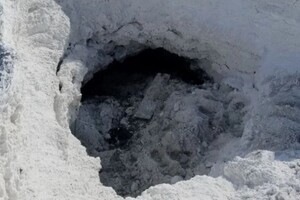Water here is characterized by low oxygen content, sub-zero temperatures and high salt content.

Scientists again managed to find life in an environment that would be the most unsuitable for most organisms living on our planet. The Lost Hammer source in the Canadian Arctic reports Science Alert.
Read also: Scientists have discovered the largest bacterium in the world
It is fed by water that passes through a 600-meter layer of permafrost, the water temperature in it drops below zero, it has a low oxygen content and a high salt content. But in spite of everything, scientists have managed to find microbes that live in salt water that seeps through the permafrost. And this may indicate the possible existence of life on Mars, Europe or Enceladus.
It is very difficult to find extraterrestrial life. Scientists believe that the best way to search would be to focus on an environment that intersects as much as possible with worlds that can support life. At first glance, sea worlds, such as Jupiter's moon Europa or Saturn's moon Enceladus, have little in common with the desert of Mars. But there are characteristics that will be common to them.
Evidence suggests that extremely cold salty oceans may be hiding beneath the icy shells of Europe and Enceladus. There may also be liquid salt lakes on Mars, locked below its surface. These media are probably hypersalted. Because salts lower the freezing point of water, it is likely to fall below zero. And more than possible, they have very little oxygen.
Scientists have recently found evidence that very salty lakes may be hiding under Mars' southern polar cap. Although this discovery is still debated, if there is a lake, it is very similar to the Lost Hammer source.
Water seeps from the depths of permafrost, its oxygen saturation does not exceed 1%, and salinity – 24%, the temperature drops to minus five degrees Celsius. It would seem impossible to live in such conditions, but the microbe somehow succeeds.
Scientists have sought to find out whether life can exist in the source of Lost Hammer, because it is similar to the presumed salt lakes of Mars. According to study lead author Aliss Mangusson of McGill University in Canada, it took several years to work with sedimentary rocks before researchers could identify active microbial communities.
The next step was to characterize these communities. To do this, the team sequenced fragments of genetic material found in the samples and divided them into many microbes belonging to different known microbial types. Most of the microorganisms discovered were new to science and had special characteristics that helped them survive in an inhospitable source.
“The microbes we found and described in Lost Hammer Spring are amazing because, unlike other microorganisms, their lives are independent of organic matter or oxygen. Instead, they survive by feeding on and inhaling simple inorganic compounds such as methane, sulfides, sulfate, carbon monoxide, and carbon dioxide, all of which have been found on Mars. They can also capture carbon dioxide and nitrogen from the atmosphere, making them highly adapted to both survival and prosperity in very extreme conditions on Earth and beyond, ”said microbiologist Layla White of McGill University.
< In the future, the team plans to grow and study some of the most active members of the microbial community to try to learn more about how they have adapted to living in such an inhospitable environment. According to researchers, this information can help us better understand the likelihood of organisms in places such as Mars.
Earlier a team of scientists from New Zealand found that under the shelf glacier of Antarctica in a domed cave live swarms of small sea creatures resembling shrimp . They live in a developed ecosystem that has only recently been hidden by glaciers.




